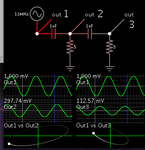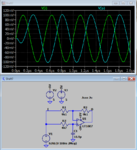Fikadu
Junior Member level 3
Sorry, I don't have much idea about Circuit design. I am trying to use allpass filter as 90 degree phase shifter. I just followed what stated in the link: https://en.wikipedia.org/wiki/All-pass_filter
Using upc815c as OP AMP with Rx = 5.1Ω , C =12pF and calculating R = 1/(2ΠfC) = 978Ω, where Power frequency f = 13.56MHz.
My problem is that amplitude of the output fluctuates too much and phase shift reading from input to output also fluctuates from negative to positive while testing on oscilloscope(like -130, -85 , -30,-5, 16,48,60,92,94,114,144..etc).
would you help me please why this happened?
Thank you a lot.
Using upc815c as OP AMP with Rx = 5.1Ω , C =12pF and calculating R = 1/(2ΠfC) = 978Ω, where Power frequency f = 13.56MHz.
My problem is that amplitude of the output fluctuates too much and phase shift reading from input to output also fluctuates from negative to positive while testing on oscilloscope(like -130, -85 , -30,-5, 16,48,60,92,94,114,144..etc).
would you help me please why this happened?
Thank you a lot.

